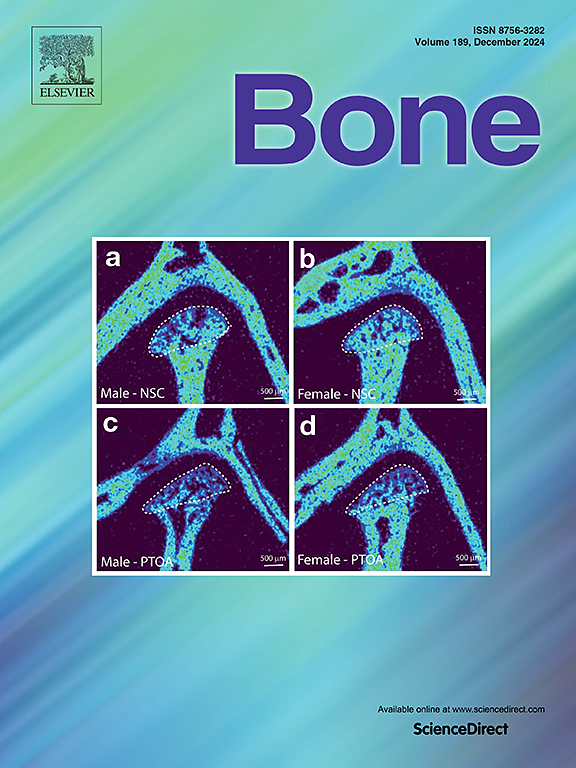Cathepsin D and G expression correlates with human fracture healing phases and specific neutrophil N1 and N2 phenotypes
IF 3.6
2区 医学
Q2 ENDOCRINOLOGY & METABOLISM
引用次数: 0
Abstract
Background
The role and involvement of immune cells in the fracture healing cascade, specifically neutrophils, is not yet fully understood. During tissue regeneration, cathepsin (CTS) D and cathepsin G have been identified as being involved in various cellular processes and associated with neutrophil function. This study aimed to determine the expression of these 2 cathepsins in fracture hematoma. Firstly, these two cathepsins were identified and scrutinized using a bioinformatics approach. Secondly, these two cathepsins were investigated for their expression in the human fracture hematoma (FH) as well as in N1 (pro-inflammatory) and N2 (regenerative) neutrophil phenotypes.
Methods
To review the latest research on CTSD and G gene expressions in fracture healing, bioinformatics analysis was firstly performed. Subsequently, to identify CTSD and G genes, the expression of them was assessed in human FH samples throughout different phases of the fracture healing cascade, and potential correlations with patient characteristics were explored. To confirm that gene expression translated to protein production, their corresponding protein levels in FH were evaluated via immunofluorescence. Finally, human neutrophils were harvested and polarized into N0, N1, or N2 phenotypes, after which their expression of CTSD and CTSG was analyzed.
Results
Bioinformatics analysis revealed distinct expression patterns of CTSD and CTSG in the fracture healing cascade in one earlier rodent study. In human, 58 FHs (0–19 days post-trauma) were harvested. The expression of CTSD significantly increased over fracture healing time, while the expression of CTSG remained constant throughout the early phases of fracture healing. Both proteins were found to be expressed throughout the FH. In neutrophils from five human donors, the expression of CTSD was higher in N2 neutrophils compared to N1, while CTSG was expressed more in N1 compared to N2 neutrophils.
Conclusion
This study was the first to investigate the association of CTSD and CTSG in the fracture healing cascade. It was shown that the expression of CTSD enzyme was associated with early fracture healing phases, as well as with specific neutrophil phenotypes (N1 or N2). Furthermore, these expression dynamics of CTSD and CTSG support the increasing N2/N1 phenotype ratio over time during fracture healing in humans, reflecting a shift from inflammation to regeneration.
The translational potential of this article
This study determined to investigate the cathepsin D and G expression in human fracture healing after reviewing the latest research progress. Along with characterizing the dynamics of these cathepsins in fracture hematoma, we demonstrate their association with two distinct neutrophil phenotypes, N1 and N2. These findings enhance the understanding of cathepsins and the roles of N1 and N2 neutrophils in fracture healing, providing a theoretical foundation for developing future therapies and biomaterials.

组织蛋白酶D和G的表达与人类骨折愈合阶段和特定的中性粒细胞N1和N2表型相关
免疫细胞在骨折愈合级联中的作用和参与,特别是中性粒细胞,尚未完全了解。在组织再生过程中,组织蛋白酶(CTS) D和组织蛋白酶G已被确定参与各种细胞过程并与中性粒细胞功能相关。本研究旨在检测这两种组织蛋白酶在骨折血肿中的表达。首先,使用生物信息学方法鉴定并仔细检查了这两种组织蛋白酶。其次,研究了这两种组织蛋白酶在人骨折血肿(FH)以及N1(促炎)和N2(再生)中性粒细胞表型中的表达。方法回顾骨折愈合过程中CTSD及G基因表达的最新研究进展,首先进行生物信息学分析。随后,为了鉴定CTSD和G基因,我们在骨折愈合级联的不同阶段评估了人类FH样本中CTSD和G基因的表达,并探讨了它们与患者特征的潜在相关性。为了证实基因表达转化为蛋白质产生,我们通过免疫荧光技术评估了FH中相应的蛋白质水平。最后采集人中性粒细胞,将其极化为N0、N1和N2表型,分析其CTSD和CTSG的表达。结果在早期的一项啮齿动物研究中,生物信息学分析揭示了CTSD和CTSG在骨折愈合级联中的不同表达模式。在人类中,收获58个FHs(创伤后0-19天)。CTSD的表达随骨折愈合时间的延长而显著增加,而CTSG的表达在骨折愈合早期保持不变。发现这两种蛋白在整个FH中表达。在5个人类供者的中性粒细胞中,CTSD在N2中性粒细胞中的表达高于N1中性粒细胞,而CTSG在N1中性粒细胞中的表达高于N2中性粒细胞。结论本研究首次探讨了CTSD和CTSG在骨折愈合级联中的相关性。结果表明,CTSD酶的表达与骨折早期愈合阶段以及特定的中性粒细胞表型(N1或N2)有关。此外,这些CTSD和CTSG的表达动态支持人类骨折愈合过程中随着时间的推移而增加的N2/N1表型比率,反映了从炎症到再生的转变。本研究在回顾最新研究进展的基础上,决定进一步探讨组织蛋白酶D和G在人体骨折愈合中的表达。随着这些组织蛋白酶在骨折血肿中的动态特征,我们证明了它们与两种不同的中性粒细胞表型,N1和N2的关联。这些发现增强了对组织蛋白酶以及N1和N2中性粒细胞在骨折愈合中的作用的认识,为未来治疗和生物材料的开发提供了理论基础。
本文章由计算机程序翻译,如有差异,请以英文原文为准。
求助全文
约1分钟内获得全文
求助全文
来源期刊

Bone
医学-内分泌学与代谢
CiteScore
8.90
自引率
4.90%
发文量
264
审稿时长
30 days
期刊介绍:
BONE is an interdisciplinary forum for the rapid publication of original articles and reviews on basic, translational, and clinical aspects of bone and mineral metabolism. The Journal also encourages submissions related to interactions of bone with other organ systems, including cartilage, endocrine, muscle, fat, neural, vascular, gastrointestinal, hematopoietic, and immune systems. Particular attention is placed on the application of experimental studies to clinical practice.
 求助内容:
求助内容: 应助结果提醒方式:
应助结果提醒方式:


